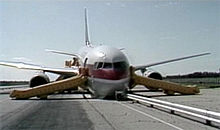A 'Fuelish' Mistake
By Mike Davenport, EAA 89102, Langley, British Columbia
March 2020 - I was driving home from the airport and, while stopped for a red light, in front of my startled eyes an aircraft appeared just above the trees. It was travelling from right to left and descending in a place that no airplane should ever be. It travelled another hundred yards and hit some large trees while still about 50 feet in the air. It appeared as though the trees opened up to let it through and then closed behind it with no sign of its passing.
I knew the aircraft and its owners, so my anxiety level was over the top. After a seeming eternity the light finally turned green and I headed for the site. By the time I got there, there were several others on the scene who were offering help to the two occupants. The plane was nose down leaning against one of the trees, wings broken and fuselage damaged. While the damage to the plane was extensive, fortunately neither the pilot nor his passenger seemed to have any significant injuries.
How did this come to be? What was the cause? To my somewhat educated eye, a first guess was engine failure. The airport was less than a mile north of the crash site, so surely a landing could have been attempted. The aircraft had recently come out of an extensive, 13-year restoration after many years in storage, and perhaps some 70-year-old part had failed. Certainly, all of this was speculation, as only the pilot would know for sure.
As the days and weeks went by and the emotions of the moment dissipated, the cause of the accident became clearer.
A group of area pilots had taken a day trip into the interior of the province and were on their way home. Some had stopped for fuel in Hope or Chilliwack, the accident plane did not, believing that they had sufficient fuel to get home.
They did.
What they didn't have was sufficient fuel for the go-around that was required by a balked landing and the subsequent overshoot. Apparently, the engine lost power during the climb out due to fuel starvation.
Transport Canada regulations require a 30-minute fuel reserve for a VFR flight. In my case, the Stinson has 36 gallons useable in two 20-gallon tanks. At cruise, the Franklin engine consumes 12 gallons an hour. This mandates two-and-a-half-hour legs, leaving fuel for diversions, etc.

The famous Gimli Glider — a classic example.
Like most pilots, I try to understand the cause of any incidents that occur and apply that knowledge to my own flying. After all, as Eleanor Roosevelt is credited with saying, "Be prepared to learn from the mistakes of others for you shall not live long enough to make them all yourself."
